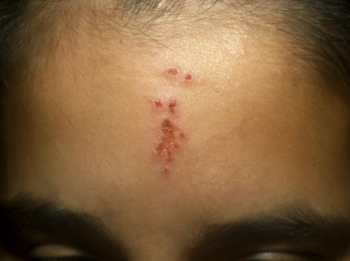
- Consultant for Pediatricians Vol 7 No 2
- Volume 7
- Issue 2
Cutis Marmorata in an Infant Boy
This lacy, purplish skin discoloration was noted on the trunk and lower extremities of a 6-week-old boy during a well-baby visit. The mother had noticed the discoloration periodically since birth. It was most apparent when the baby was cold.
This lacy, purplish skin discoloration was noted on the trunk and lower extremities of a 6-week-old boy during a well-baby visit. The mother had noticed the discoloration periodically since birth. It was most apparent when the baby was cold. This skin abnormality is cutis marmorata--a physiological dilatation of capillaries and venules of the trunk and extremities in infants and young children caused by exposure to cold. The discoloration fades with warming, as was the case with this baby. The condition is seen especially when subcutaneous fat is decreased.
Reassurance that nothing is wrong and keeping the baby warm are the only treatments necessary. As the infant gains weight, the condition resolves, usually after several weeks or a few months. Persistent cutis marmorata may occur with Down syndrome, trisomy 18, and Cornelia de Lange syndrome.1 In cutis marmorata telangiectatica congenita, the vessel dilatation persists even after rewarming and has a deep violaceous color. *
References:
REFERENCE:1. Paller AS, Mancini AJ. Hurwitz Clinical Pediatric Dermatology: A Textbook of Skin Disorders of Childhood and Adolescence. 3rd ed. Philadelphia: Elsevier Saunders; 2006:19.
Articles in this issue
almost 18 years ago
Neonate With Down Syndromealmost 18 years ago
Bell Palsy in Lyme Disease: More Than Meets the Eyealmost 18 years ago
Histiocytosis X and Lichen Sclerosus et Atrophicusalmost 18 years ago
Temper Tantrums: Cause for Concern--or Normal Behavior?almost 18 years ago
Juvenile Laryngeal Papillomatosis: An Unexpected Cause of Stridoralmost 18 years ago
Pityriasis Rosea in a Young Boyalmost 18 years ago
Pelvic Bruising in a Young Girlover 18 years ago
Secondary Syphilis in a Teenage BoyNewsletter
Access practical, evidence-based guidance to support better care for our youngest patients. Join our email list for the latest clinical updates.









